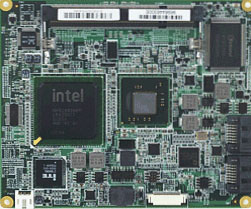If you’re an embedded-systems designer looking for compute power, you have a lot of options. I don’t know how many companies make single-board computers, but it is a lot. Maybe 200? And most of those offer a number of different formats.

Maybe there’s too many choices. You can use EPX, PC-104, Epic, Gumstix, Beagle Board, Raspberry Pi, and on and on.
One approach is the system on module (SoM). Think of the SoM as an extended processor chip. You design a carrier board (or base board) with your special functions on it and then plug in a SoM for the processing power. A system on module is a small processor module with CPU bus accessibility and standard I/O. It has buffers and PHYs for all the communications functions coming out of the processor, an oscillator, and debug ports. Next year, if you want to step up to the latest version, you just plug in an updated module. It’s an alternative to full custom engineering, and you can get yourself an off-the-shelf carrier board that will allow you to get on with the software design before you have your special unit complete. This means an engineer can focus more on the custom aspects of the project that makes it unique.
With a SoM approach you get the best of aspects of buying an off-the-shelf single-board computer and of a custom engineered solution. I think of it as dividing a single-board computer in half — the processor half being a module. It is not standardized, because the module interface can be any format and have any type connector. The SoM module does not have any connectorization and is designed to be plugged into a carrier board. It’s very embeddable. But, the definition of SoM, which some call computer-on-module (CoM), is a bit fuzzy. It’s the general concept that counts.
One SoM example is MicroZed, offered by Avnet (http://tinyurl.com/m5x8r4w), which features a Xilinx Zync Programmable SoC FPGA with dual Cortex-A9 processors. It comes in either standard or extended temperature versions. With MicroZed you can chose a Zynq 7010 or 7020 with 28 K or 85 K logic cells and 240 or 560 Kbytes of block RAM. The card also has dual 10/100/1,000 Ethernet MAC and PHY, 1 Gbyte of DDR3 SDRAM, 128 Mbytes of QSPI flash, a Micro SD card interface, USB 2.0, USB-UART. Of course, Avnet offers a complete set of design tools for Zynq hardware and software design.

Avnet's MicroZed System on Module
EMAC (www.emacinc.com) makes a number of SoMs, including 144- and 200-pin SODIMM modules, ETX format modules, and COM Express modules. The company's SoM-4463 module that fully complies with the SoM-ETX form factor has an Atom N450/D510 +ICH8M chipset, which supports PCI and ISA interfaces. In a basic form factor of 95 x 114 mm, the card has lots of I/O capability with 10/100 Ethernet, audio and video, quad PCI, ISA, IDE, USB 2.0, dual SATA, and a 18-bit LVDS interface. With an N450 CPU and 2 Gbytes of RAM, it costs $284.

EMAC's Atom-based module
Kontron (www.kontron.com) offers the SMARC-sAMX6 ultra-low-power ARM-based module based on the Freescale i.MX6 family with dual- or quad-core Cortex A9 CPUs. The 82 x 50-mm card has 10/100/1,000-Mbit Ethernet, SATA, a graphics controller, 5x I²C, 2x I²S, 2x SPI, SPDIF, WDT, 2x CAN, and three PCIe x1 lanes. It also has a camera interface (PCAM, CSI) and up to 2 Gbytes of DDR3. Typical power consumption is just 5 W.
New from GE Intelligent Platforms (www.ge-ip.com) is the mCOM10-L1500 COM Express module. This card uses the latest-generation AMD Embedded G-Series SOC. It features a small 84 x 55-mm size, a rugged design with soldered components, and a graphics interface. The four core version takes just 15 W and the two core just 9 W. The card has A GbE port, eight USB 2.0 and two USB 3.0 ports, four PCIe lanes, and two Serial ATA interfaces.
Advertisement
Learn more about Electronic Products Magazine





